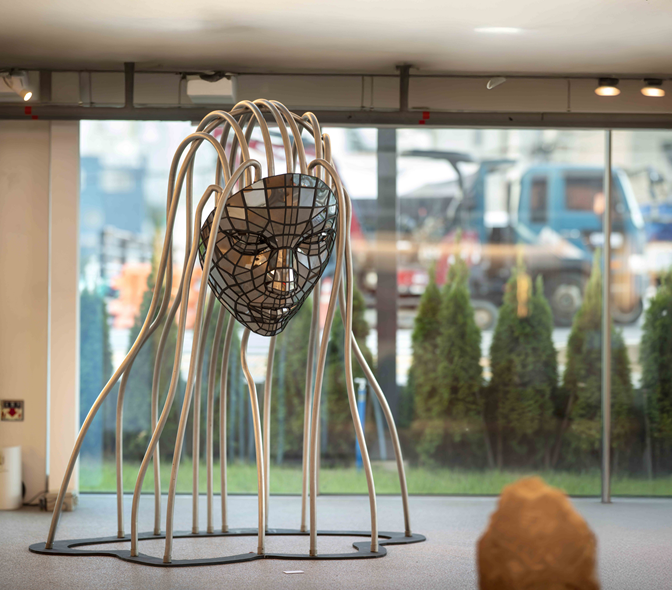

거울 가면 : Mirror Mask
작가 한승구의「Mirror Mask」는 정체성, 자기 인식, 그리고 사회적 위장의 이중성을 탐구하는 작업이다. 작품의 핵심에는 근본적인 질문이 놓여 있다. “가면이 숨길 때, 과연 무엇이 드러나는가?” 가면은 단순히 얼굴을 가리는 데 그치지 않는다. 그것은 외부 세계에 전혀 다른 이미지를 투사하는 스크린이 된다. 숨김과 드러남 사이의 긴장 속에서 「Mirror Mask」는 의미를 발견한다.
전통적으로 가면은 얼굴을 가리고 그 이면을 숨기는 덮개의 역할을 해왔다. 그러나 동시에 가면은 새로운 정체성이 연기되는 무대, 표면이 되기도 한다. 「Mirror Mask」에서 한승구는 이러한 역설적인 성질을 포착하기 위해 거울을 매개체로 사용한다. 투명한 거울 뒤에는 조각된 얼굴이 드러나 있는 듯 보인다. 하지만 관람자가 다가서는 순간, 거울은 다시 반사체로 기능하며 조각의 얼굴은 사라지고 관람자의 모습만이 나타난다.
이러한 전환적 만남은 관람자가 가면 뒤의 ‘진짜 얼굴’에 접근하지 못하도록 만든다. 대신 관람자는 사회적 구조와 기대에 의해 위장된 자신의 모습과 마주하게 된다. 작품은 ‘실재’를 확인할 수 없게 하고, 드러나는 것은 작가의 숨겨진 얼굴이 아니라 관객 자신의 위장된 정체성이다. 이처럼 「Mirror Mask」는 정체성이 결코 단일하지 않으며, 층위적이고, 연기되며, 매개된 것임을 드러낸다.
또한 동시대 사회의 더 큰 질문들과 공명한다. 디지털 페르소나, 큐레이션된 프로필, 매개된 외양이 지배하는 시대에 가면은 현대적 정체성의 은유가 된다. 작품이 관람자로 하여금 자신의 반영된 모습만을 마주하게 하듯, 우리의 디지털 가면 또한 이상화된 자아를 보여주면서 동시에 취약함을 숨긴다. 결국 우리는 질문하게 된다. 우리는 과연 진정으로 보이는 것일까, 아니면 언제나 가면—자신의 것이든 타인의 것이든—만을 마주하는 것일까?
작품의 제목「Mirror Mask」는 이러한 이중적 움직임을 완벽하게 담아낸다. “Mirror”는 반영, 대면, 불가피한 자기 인식을 의미하고, “Mask”는 위장, 은폐, 변신을 뜻한다. 이 둘이 결합할 때, 정체성이 어떻게 드러나고 숨겨지며, 진실하면서도 인위적이고, 진정성이 있으면서도 연기되는지를 상징하는 강력한 은유가 된다.
관람자를 이 역동 속에 위치시킴으로써, 한승구는 「Mirror Mask」가 단순히 바라보는 조각이 아니라 경험해야 하는 작품이 되도록 한다. 작품은 참여를 요구하며, 각 만남을 불안하면서도 깊은 자기 인식의 순간으로 변모시킨다. 그런 의미에서 「Mirror Mask」는 단순한 오브제가 아니라 사회 자체의 거울이 되어, 정체성이 어떻게 형성되고, 위장되고, 협상되는지를 드러낸다.
궁극적으로「Mirror Mask」는 정체성이 벗겨져 드러나기를 기다리는 고정된 본질이 아니라, 끊임없이 자아와 사회 사이를 오가며, 숨김과 연기 사이에서 움직이는 유동적이고 변화하는 구조임을 제안한다. 이처럼 한승구의 작업은 단순히 가면을 보여주는 것이 아니라, 우리가 이미 그 속에서 살아가고 있음을 드러낸다.
Mirror Mask by artist Han seung ku is an artwork that delves into the duality of identity, self-perception, and social disguise. At its core, the work asks a fundamental question: what is truly revealed when a mask conceals? The mask does not merely hide the face; it becomes a screen that projects an entirely different image to the outside world. In this tension between concealment and revelation, Mirror Mask finds its meaning.
A mask traditionally functions as a cover, shielding the face and hiding what lies beneath. Yet at the same time, the mask itself becomes a stage, a surface upon which a new identity is performed. In Mirror Mask, Han seung ku uses the mirror as a medium to capture this paradoxical nature. Behind the transparent mirror lies a sculpted face, seemingly present and available to the viewer. But as the audience approaches, the mirror shifts its role—reflecting rather than revealing. The sculpture’s face disappears, replaced by the image of the viewer.
This shifting encounter denies the audience access to the true face behind the mask. Instead, the viewer is confronted only with their own reflection, altered by the social expectations and structures that dictate identity. The sculpture makes it impossible to see what is “real.” What emerges is not the artist’s hidden face, but the disguised identity of the spectator themselves. In this way, Mirror Mask embodies the notion that identity is never singular, but layered, performed, and mediated.
Han seung ku’s Mirror Mask also resonates with broader questions of contemporary society. In an era dominated by digital personas, curated profiles, and mediated appearances, the mask becomes a metaphor for modern identity. Just as the work forces the viewer to confront only their reflected image, our digital masks project an idealized self while concealing vulnerabilities. The audience is left to wonder: are we ever truly seen, or do we only ever encounter masks our own and those of others?
The title Mirror Mask captures this double movement perfectly. “Mirror” signifies reflection, confrontation, and the inevitability of self-awareness. “Mask” signifies disguise, concealment, and transformation. When combined, they form a powerful metaphor for the ways in which identity is both revealed and hidden, genuine and artificial, authentic and performed.
By positioning the viewer within this dynamic, Han seung ku ensures that Mirror Mask is not merely a sculpture to observe, but an experience to undergo. The artwork demands participation. It transforms each encounter into a moment of self-recognition, unsettling yet profound. In this sense, Mirror Mask is more than an object; it is a mirror of society itself, reflecting how identity is shaped, disguised, and negotiated in every interaction.
Ultimately, Mirror Mask proposes that identity is not a fixed essence waiting to be unveiled, but a liquid and shifting construct, always in motion between self and society, between what is hidden and what is performed. In this way, Han seung ku’s work does not simply show us a mask—it reveals how we are already living within one.


